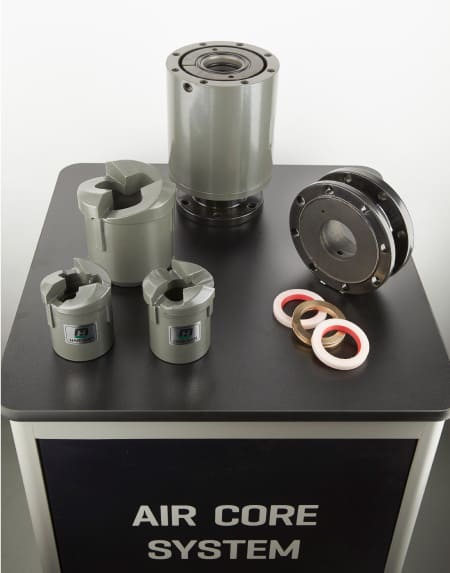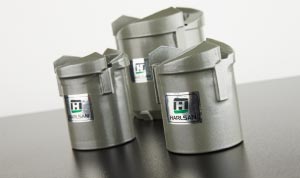What Is Air Core Drilling?
An introduction to the benefits of Air Core drilling
What is air core drilling? Air core drilling uses three-bladed steel or tungsten drill bits to bore holes into unconsolidated ground and is used when safe and clean removal of sample material is paramount.
Things we’re covering in this article:
- How does air core work?
- Where is air core drilling applied?
- The advantages of air core drilling
- The disadvantages of air core drilling
- The importance of good quality air core drilling bits
- What’s the difference between air core drill and RC drilling?

Air core drilling is an inexpensive method of exploration drilling that can be employed when safe removal of sample material is paramount. Where possible, it is preferred over RAB (Percussion rotary air blast drilling) drilling and unlike the diamond drilling method, which withdraws a small diameter core of rock from the orebody, air core drilling is much faster and more cost-effective.
As the name suggests, air core drilling relies on compressed air to flush cutting samples out of your drill holes. This enables the safer collection of samples without unnecessary damage to the surrounding area and results in a more effective analysis sample.
Where is Air Core Drilling Applied?
Air core drilling is a valuable method of drilling for organisations looking to reduce the risk of sample cross-contamination. It’s commonly used in first-pass exploration drill programs on unconsolidated ground, with an optimal depth of up to 300 metres.
Advantages of Air Core Drilling
Air core drilling has clear advantages over other drilling methods.
- It eliminates the need for casting holes.
- It provides a more representative sample of material. The nature of the expulsion of the materials provides samples that are easier to analyse.
- Delivers safer sample removal. Due to its reliance on compressed air injection, air core drilling involves less damage to the samples, when compared with blast drilling.
- Boosts efficiencies and reduces costs. Air core drilling is an efficient method for removing material. It enables real-time sample collection, which speeds up drilling rates, resulting in reduced field costs. Air core drill rigs are also lighter in weight than other rigs, meaning they’re quicker and easier to transport.
- Less chance of cross-contamination. As compressed air is used to flush the cuttings through the inner tube, there is less sample pollution than other methods.
Disadvantages of Air Core Drilling
While there are many advantages to air core drilling, it also comes with disadvantages when compared to other methods of drilling.
- Air core drilling can be slower. While air core drilling is considered more efficient, the drills typically operate at a slower speed than other methods, making the drill process itself slower.
- Depth limited. Depending on a number of variables but predominantenly available air pressure, air core drilling is usually limited to depths of 50-120m.
- Fresh rock penetration limited. While air core drilling is able to drill through cap rock at the top of a hole using a hammer or tri-cone roller, air core drilling is usually unable to penetrate fresh rock.
The Importance of Good Quality Air Core Drilling Bits
Good quality air core drilling bits are invaluable, and can make all the difference in your drilling program.
The better-quality your drill bit, the better your results. A good quality drill bit will use better materials in its manufacturing process, making it stronger, and more able to hold up to stress (such as drilling through quartz). They’re built for reliability and versatility, with improved shock resistance built into the blade and shell design.
Poor quality air core drill bits aren’t as efficient, so they take longer to complete your drilling. They’re more likely to break, and ultimately end up wasting your time, and costing more money. With a poor-quality drill bit, you run the risk of material blocking your drill and inner tubes, particularly in thick, clay-like earth.
At Harlsan’s, our air core drill bits are manufactured to the highest standards. They’re built tough, designed to be robust enough to handle whatever your drilling operations throw at them.
What’s The Difference Between Air Core Drilling and RC Drilling?
While the equipment used in air core drilling and RC drilling is similar, the mechanisms involved are different, so each is useful in different situations.
Both involve the use of compressed air to flush out samples. However, air core drilling is ideal where unconsolidated ground is present.
RC drilling on the other hand, uses the added element of concussive force to power the drill bit, pulverising the rock in its path. This makes RC drilling ideal for harder ground. RC drilling is also typically able to achieve greater depths, and better-quality samples, than other types of drilling.
Get Air Core Drilling Support From the Experts
At Harlsan’s, we’re experts in supporting drilling companies in getting the most value from your air core drilling programs.
Ready to start your next venture? Get in contact with us today for advice, support, and assistance in setting up for your next air core drilling project. We’ll help you choose the right equipment so you can get the best result from your program, every time.
Keep Up With Harlsan Product News & Innovation





 Youtube
Youtube LinkedIn
LinkedIn Facebook
Facebook Instagram
Instagram